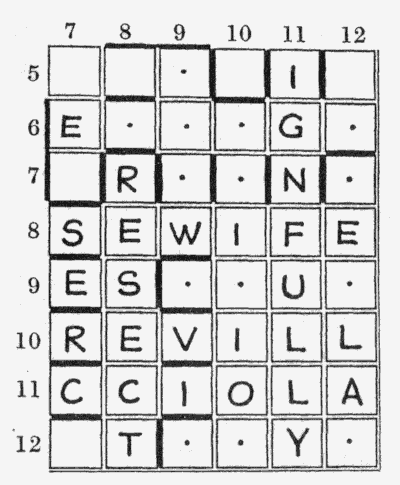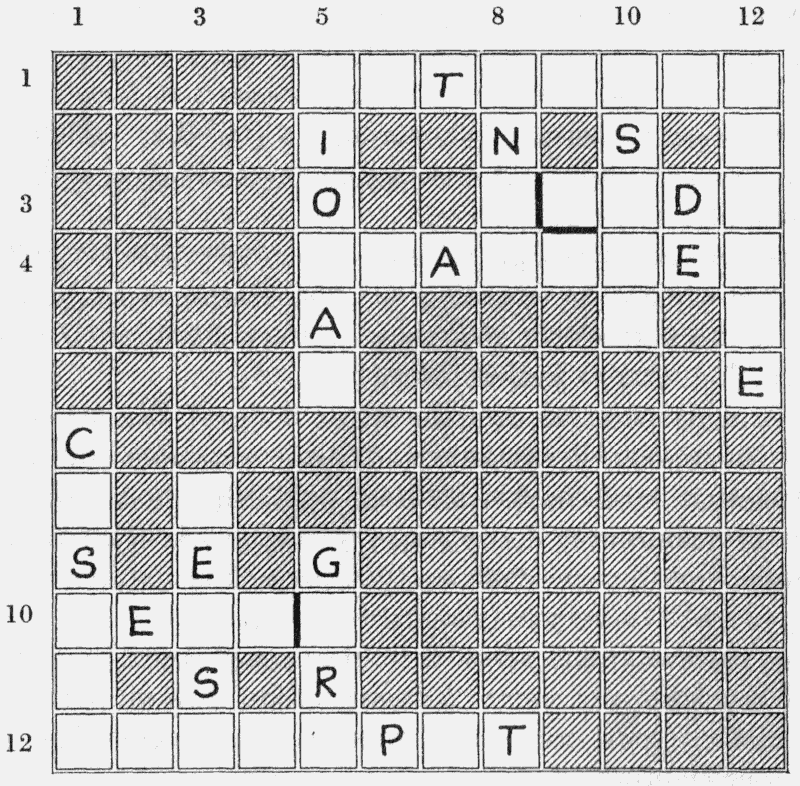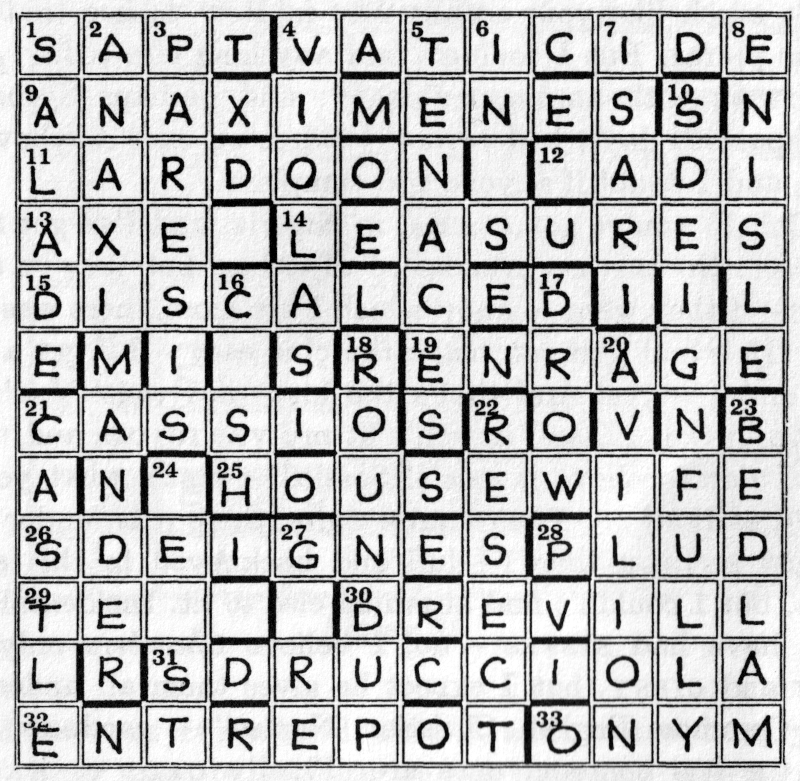Ximenes On The Art Of The Crossword
Composing a Ximenes, the letters
In bed last night you suddenly remembered that when SDRUCCIOLA caught your eye in the dictionary, you noticed that there was another word next to it beginning with SD. So this morning you look it up to see if it would be fun to work it in. You find
there are several — ’SDEATH, SDEIGNE, SDEIN, SDAINE, SDAYN, SDEIGNFULL(Y). And there’s already a second letter D in Row 9. Eight letters: put in SDEIGNES. What about putting SDEIGNFULLY in Col. 11? Naughty, and rash; but put it there as long as you are prepared to scrap it at the least provocation. Does it cause any obvious awkwardness? Perhaps the F in Row 8 is the most dangerous feature: use the rhyming dictionary. It opens, naturally enough, at the -Es: try -FE. VOUCHSAFE and HOUSEWIFE. You notice that VOUCHSAFE produces -HS— in Col. 8: so put in HOUSEWIFE.
Here you ask “Can’t we stop talking about Rows and Columns now, and put in the numbers?” No, because you will keep rubbing one out when you alter a letter. “Not if I write them in ink.” What if you want to move a bar? Besides, you wouldn’t save anything: “Col. 8” is as short as “22 dn.” “I see.”
Col. 6 must come next: --UN-U-. Use Chambers: -ful, -um, -us? Wait: you think there’s a name BLUNDUN. Can you remember who or what it is? No. Then try S-UN-U-, which has a possible air about it. SPUN-OUT; but you would prefer a consonant for the fifth letter, because it starts an across word. Back to B, etc., etc. … till you find ROUND-UP: it would be the fourteenth consonant you tried, with T the only other likely one left! But remember that you got HOUSEWIFE quickly: luck evens out when you’re composing crosswords, just as it does at bridge: there are good runs as well as bad.
Col. 8? Is there a word RESECT? Yes. Row 10? You probably don’t know there’s a word DREVILL, but you will come to it early, as it begins with D: very lucky, and don’t you forget it when you get stuck later on ~ you haven’t got stuck at all yet.
The south-east corner now looks like this:

Dots represent the missing letters of the six words still needed, which won’t be seriously affected by any other words. The south-east corner is apt to be sticky, because you so often have to work from endings and not from beginnings; but this one really doesn’t look formidable.
So leave it till later and move on to the north-west corner, which is usually the easiest.
Here you must first find a nine letter word for Row 5: -I----C–: B looks bad for Col. 1, so start in Chambers at C (unless you can think of a word quickly? No, you can’t: nor can I). No Cs strike you: go on to D. Pause at the comic-looking DIPHYCERCAL, and enter it in the back of Chambers, where you’re going to keep a list for future puzzles. Soon you come to DISCALCED: I might have to ban that, because I think I’ve used it lately — I’ll go and see. . . . No, it’s all right: I must have met it when solving: put it in.
The final D now sends you back to Fig. 24, where D–W now crosses E—G-. You had better finish your “easy corner” before going any further.
Row 6: ENGAGE? No: it gives DG-W, which might be a place in Czechoslovakia, but I doubt it. ERIDGE and Belvedere? Or has that got two Rs? Atlas: lunatic! It’s Erith, of course. Is ERIDGE anything? Only the end of Coleridge. (Actually I discovered later that there is a small place called Eridge Green in Sussex; but DI-W is impossible anyhow). EATAGE? No: it gives you an attack of D.T.s. ENRAGE! Idiotic not to think of it before! Put it in. You now find there is DROW, as well as DRAW and DREW, which are dull. And look! It’s a back word going down: that should be easy to clue. You might want to make it go across instead of down: if so, you merely turn the diagram inside out when you’ve finished it, so that the acrosses become downs and vice versa.
Now “the island valley of AVILION” (pavilion with the roof off) stares you in the face. It hasn’t got two Ls has it? No! Sure? Yes! Better look, all the same. … Right.
SNYE in Row 12? No such word. I thought there was: perhaps it’s in the old edition: look and see. … No: I was thinking of SNY, which is there. ONYX? Then -E-LAX in Col. 12: No. ONYM? BEDLAM in Col. 12. Nearly there, but look at -LUD! ‘Sblud! Wasn’t there a left-hander in the O.T. called Elud? Ehud, you ass! But Elud does sound possible: look at Cruden’s Concordance.
A useless search except that you noted down Keilah for future use! Then try Philips’ Record Atlas, the Everyman Encyclopaedia Atlas, and the gazetteer at the end of the old edition of Webster: still nothing, except Petlad for future use!
In final desperation, try the main body of the old Webster, which can make almost any short pronounceable collection of letters into a word. At last! PLUD, “a puddle, pool. (Obs. except dial.)” in a footnote. You would try very hard to avoid that in a competition puzzle, but we’ll suppose that this one isn’t, and give PLUD a very easy clue,
Well, that will teach me to talk about easy south-east corners! It was my fault, not yours: I ought to have known better. Still, that hold-up took only forty minutes, and I have had many much longer ones.
Back to the north-west corner. On the way, C–H in Col. 4, catches your eye, crossing -A—O in Row 7: you had better settle that. CASTRO? No, Cath isn’t given on p. 1350, though one would have said it was commoner than such names as Berenice and Clothilda — that clot, Hilda? Get on, and don’t waste time! CASSIO. Leave C-SH till you write the clues.
Col. 3. Is there a word PARESIS? Yes.
Row 4. OXER? Yes, unless I’ve used it lately. … No: put it in.
Col. 1 next: -A-OD-. PARODY? No: RAR—N looks hopeless in Row 3. If you can’t think of another quickly, try AXE- instead of OXER. SALADS, or SALADE, spring to mind, and isn’t there a word LARDOON? Yes. Put your very old friend Colonel SAPT in at the top. When did I last use him? . . . July 1960: high time he had another outing.
That completes the north-west corner, and you have reached

Good heavens! It’s after 1 o’clock, and we feel hungry and thirsty. That must be because we got engrossed in letters and forgot all about bars. Well, at least we’ll stop for lunch now.
3 o’clock. I was hoping you would wake up soon. I’ve just been checking the proportion of rare to common words in the diagram so far. I make it fourteen rare, ten common. I always aim at fifty-fifty, or rather eighteen-eighteen, so you mustn’t have many more rare ones.
Now, if you’re really awake, why don’t you carry on composing by yourself, and see if you can race me? We’re sure both to put the same word into Col. 5 to complete -IO-A-: how shall we continue from there? Don’t bother with dictionaries unless you get stuck: let the two or three rare words we want come out of your own stock.
4 o’clock. Finished yet? If not, I’ll try to help. I see you’ve got VIOLAS: I was sure you would. But you’ve got VATICANS in Row 1: surely there’s only one? Try my VATICIDE instead.
You can leave your INNS in Col. 8 (much nicer than INKS). I don’t much like your LEASURES in Row 4: has that got a genuine plural? But I couldn’t find anything else either, except LEASOWES with an impossible W: and perhaps Spenser, in those spacious days, had several leisures on end. Anyhow we’ll risk it, and I doubt if anyone will complain.
In Col. 10 you’ve got ASARA, in Nigeria, and I’ve got ISARI, in Greece. No one has ever heard of either, but they’ve all got atlases — if they want to know which I use most, there was a hint on p. 115 — and you can make the clue easy — I’ll get a SARI, IRAS and I — yes. And that’s the lot — no: wait! You’ve got SOSSLE in Col. 12, and it won’t fit my VATICIDE, and, what’s more, I don’t believe it exists! Sossled — that’s what you are. The old edition? … You’re quite right: there it is, under SOSS.
I’ve got ENISLE there — dull and hackneyed in this sort of puzzle, but I couldn’t find anything else to fit. Incidentally you might have had SISSIE — no, I believe Chambers only gives SISSY and CISSY, but I expect he gives them all under “The More Common English Christian Names” — goodness knows what the less common ones are. Finally CADI or KADI for Row 3.
We’ve nearly finished, but there’s still the south-west corner. Last lap.
Get the rhyming dictionary for Row 12. ENTREPOT, “a bonded warehouse”.
Col. 1. CASTLE. Leave -E-ST, TE-- and G-RE till you write the clues. At last we really have finished: the last lap took a minute.
Let’s make a final check of the proportion of rare to common words. We find that when we choose the last six words (-ADI must be rare) we can easily equalize them.
This, at last, is the time to put the numbers in: do it carefully — it is easy to make slips (as the writer actually did in preparing Fig. 26. When a job has become a routine one, it’s very hard to concentrate).

How long have we taken? Between eight and nine hours. We took as long yesterday over the bars as we have today over the words. But that was because there was so much explaining to do yesterday. Next time, unless you are unlucky, you will be much quicker. (In actual fact, when composing this puzzle and scribbling down his thoughts as he went along — which at least doubles the time taken — the writer took about six hours.)